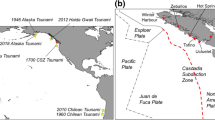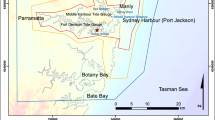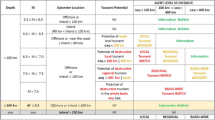Abstract
The east coast of Tasmania is directly exposed to tsunamis originating from the Puysegur subduction zone, off New Zealand’s southwest coast. However, the potential impacts of tsunami inundation for coastal communities and Hobart Airport, and risks to maritime operations in Hobart Port, are poorly understood. The purpose of this project is to simulate a maximum credible earthquake/tsunami/high tide scenario (a Mw 8.7 rupture of the Puysegur subduction zone) across a 17,000 km2 model area and provide outputs that can inform local hazard management plans. Modelling was performed using the ANUGA hydrodynamic library, along with a detailed elevation model constructed from LiDAR, photogrammetric contours and bathymetric datasets. The modelling strategy comprised three primary scenarios: a 13 h simulation of tsunami activity focusing on maritime hazard from waves and currents, with two further 4 h simulations focusing on coastal inundation for 71 coastal communities and Hobart Airport. The models were run on a variable triangulated mesh with a detailed Manning’s n surface roughness model. Tsunami erosion of sand dunes was accounted for through the development of an erosion operator. Results predict severe inundation (> 4 m flow depth) in exposed east-facing areas and the maritime hazard assessment advises that water disturbance would pose a significant threat to marine craft. The assessment suggests that the feasibility of shipping evacuation from Hobart port is questionable, given the timeframes involved and the nature of simulated water disturbance. Modelling results suggest that the dune line in front of Hobart Airport would not be breached in this instance and so inundation would not occur.












Similar content being viewed by others
References
Australian Bureau of Statistics. (2018). Regional Population Growth, Australia, 2017–2018. https://www.abs.gov.au/AUSSTATS/abs@.nsf/mf/3218.0. Accessed 23 Aug 2019.
Baldock, T. E., Barnes, M. P., Guard, P. A., Hie, T., Hanslow, D., Ranasinghe, R., Gray, D., & Nielsen, O. (2007). Modelling tsunami inundation on coastlines with characteristic form. In: Proceedings of the 16th Australasian Fluid Mechanics Conference: Gold Coast, Australia, pp. 939–942.
Barrett, N., Sanderson, J. C., Lawler, M., Halley, V., & Jordan, A. (2001). Mapping of inshore marine habitats in south-eastern Tasmania for marine protected area planning and marine management. Tasmanian Aquaculture and Fisheries Institute Technical Report Series 7.
Beccari, B. (2009). Measurements and impacts of the Chilean tsunami of May 1960 in New South Wales, Australia. New South Wales State Emergency Service Report 05/0576, p 42.
Borrero, J. C., Lynett, P. J., & Kalligeris, N. (2015). Tsunami currents in ports. Philosophical Transactions of the Royal Society A. https://doi.org/10.1098/rsta.2014.0372.
Bricker, J. D., Gibson, S., Takagi, H., & Imamura, F. (2015). On the need for larger Manning’s roughness coefficients in depth-integrated tsunami inundation models. Coastal Engineering Journal. https://doi.org/10.1142/s0578563415500059.
Burbidge, D., Mleczko, R., Thomas, C., Cummins, P., Nielsen, O., & Dhu, T. (2008). A probabilistic tsunami hazard assessment for Australia. Geoscience Australia Professional Opinion 2008/04, Canberra.
Chow, V. T. (1959). Open-channel hydraulics. New York: McGraw-Hill Book Company.
Clark, K., Cochran, U., & Mazengarb, C. (2011). Holocene coastal evolution and evidence for paleotsunami from a tectonically stable region, Tasmania, Australia. The Holocene,21, 883–895.
Commonwealth of Australia—Geoscience Australia. (2016). ARR: australian rainfall and runoff; a guide to flood estimation. http://arr.ga.gov.au/arr-guideline. Accessed 11 Dec 2016.
Cox, D. C., & Mink, J. F. (1963). The tsunami of 23 May 1960 in the Hawaiian Islands. Bulletin of the Seismological Society of America,53, 1191–1209.
Davies, P. E., Crawford, C. M., Wells, F. A., Dunstan, P., & Mitchell, I. M. (2002). Environmental flow assessment of the lower coal river and pitt water estuary. Report to DPIPWE from Freshwater Systems and the Tasmanian Aquaculture and Fisheries Institute. p. 203.
Davies, G., & Griffin, J. (2018). The 2018 Australian probabilistic tsunami hazard assessment: hazard from earthquake generated tsunamis. Geoscience Australia, Record 2018/41. https://doi.org/10.11636/Record.2018.041
Department of Primary Industries, Parks, Water and Environment (DPIPWE). (2007). LIST Tasmania 25 metre Digital Elevation Model. http://listdata.thelist.tas.gov.au/opendata/index.html#LIST_Tasmania_25_Metre_Digital_Elevation_Model. Accessed 1 Aug 2016
Department of Primary Industries, Parks, Water and Environment (DPIPWE). (2013). TASVEG 3.0: Tasmanian vegetation monitoring and mapping program. Resource Management and Conservation Division
Fernandes, M. A. G. (2009). Systematic comparison on the inundation response of AnuGA and COMCOT tsunami modelling codes applied to the Boca do Rio and Alvor Bay area. Unpublished PhD Thesis, Univerisidade do Algarve. p. 75.
Froelich, D. (2002). IMPACT project field tests 1 and 2 “Blind” simulation. 2nd IMPACT Project Workshop, Mo-i-Rana Norway.
Goff, J., & Chagué-Goff, C. (2014). The Australian tsunami database: a review. Progress in Physical Geography,38, 218–240.
Hasan, H., Lodhi, H. A., LeVeque, R. J., Lodi, S. H., & Ahmed, S. (2017). Assessing tsunami risk for Karachi Port through simulation of currents that were reportedly produced there by the 1945 Makran tsunami. In: Proceedings of the 16th World Conference on Earthquake, Santiago Chile, January 2017
Heath, R. A. (1976). The response of several New Zealand harbours to the 1960 Chilean tsunami. Bulletin of the Royal Society of New Zealand,15, 71–82.
Jakeman, J. D., Nielsen, O. M., Van Putten, K., Mleczko, R., Burbidge, D., & Horspool, N. (2010). Towards spatially distributed quantitative assessment of tsunami inundation models. Ocean Dynamics,60, 1115–1138.
Kain, C. L., Mazengarb, C., Rigby, E. H., Cohen, B., Simard, G., & Lewarn, B. (2018). Technical report on tsunami inundation modelling in South East Tasmania. Tasmanian Geological Survey Report UR2018_02. p. 160.
Kato, Y., Suzuki, Z., Nakamura, K., Takagi, A., Emura, M., Ito, M., et al. (1961). The Chile tsunami of 1960 observed along the Sanriku coast of Japan. Report series of Tohoku University, 5. Geophysics,13, 107–125.
Land Information System Tasmania. (2016). ListData Open data. https://listdata.thelist.tas.gov.au/opendata/. Accessed 11 Dec 2016.
Lucieer, V. L., Lawler, M., Morffew, M., & Pender, A. (2007). Estuarine habitat mapping in the derwent—2007. A resurvey of marine habitats by seamap tasmania. Tasmanian Aquiculture and Fisheries Institute, University of Tasmania: Hobart.
Lynett, P. J., Borerro, J. C., Weiss, R., Son, S., Greer, D., & Renteria, W. (2012). Observations and modelling of tsunami-induced currents in ports and harbors. Earth and Planetary Science Letters,327–328, 68–74.
Lynett, P. J., Borrero, J., Son, S., Wilson, R., & Miller, K. (2014). Assessment of the tsunami-induced current hazard. Geophysical Research Letters,41, 2048–2055.
Lynett, P. J., Gately, K., Wilson, R., Montoya, L., Arcas, D., Aytore, B., et al. (2017). Inter-model analysis of tsunami-induced coastal currents. Ocean Modelling,114, 14–32.
Morris, M. K., & Mazengarb, C. (2009). Historical accounts of tsunamis in Tasmania. Tasmanian Geological Survey Record 2009/04. Department of Infrastructure, Energy and Resources, Mineral Resources Tasmania.
Muhari, A., Charvet, I., Tsuyoshi, F., Suppasri, A., & Imamura, F. (2015). Assessment of tsunami hazards in ports and their impact on marine vessels derived from tsunami models and the observed damage data. Natural Hazards. https://doi.org/10.1007/s11069-015-1772-0.
Mungkasi, S., & Roberts, S. G. (2013). Validation of ANUGA hydraulic model using exact solutions to shallow water wave problems. Journal of Physics: Conference Series,423, 012029. https://doi.org/10.1088/1742-6596/423/1/012029.
Nielsen, O., Roberts, S., Gray, D., McPherson, A., & Hitchman, A. (2005). Hydrodynamic modelling of coastal inundation. MODSIM 2005 In: International Congress on Modelling and Simulation, Modelling and Simulation Society of Australia & New Zealand, pp. 518–523.
Okal, E. A., Fritz, H. M., Raveloson, R., Joelson, G., Pancockova, P., & Rambolamanana, G. (2006a). Madagascar field survey after the December 2004 Indian Ocean tsunami. Earthquake Spectra,22, 263–283.
Okal, E. A., Sladen, A., & Okal, E. A. S. (2006b). Rodrigues, Mauritius and Reunion islands field survey after the December 2004 Indian Ocean tsunami. Earthquake Spectra,22, 241–261.
Rigby, E., Mazengarb, C., Barthelmess, A., & Kain, C. (2017). Experiences developing and applying an ANUGA dune erosion operator to assess risk from loss of dune protection during a tsunami. In: Proceedings of the 13th Hydraulics in Water Engineering Conference. pp. 8
Roberts, S., Nielsen, O., Gray, D., Sexton, J., & Davies, G. (2019). ANUGA user manual. Geoscience Australia. https://anuga.anu.edu.au/
Sharples, C. (2006). Indicative mapping of Tasmanian coastal vulnerability to climate change and sea-level rise: explanatory report (p. 173). Tasmania: Consultant Report to Department of Primary Industries & Water.
Sterzai, P., Coren, F., & Creati, N. (2015). The application of open-source software ANUGA installed on a BlueJ/Q computer for a tsunami modelling in coastal areas of city of Trieste using high resolution laser-scanning and multibeam data. Planet-Risk,3(1), 121–125.
Uslu, B., Power, W., Greenslade, D., Eblé, M., & Titov, V. (2011). The July 15, 2009 Fiordland, New Zealand Tsunami: real-time assessment. Pure and Applied Geophysics,168(11), 1963–1972.
Van Putten, K., Fountain, L., Griffin, J., Sexton, J., Nielsen, O., & Wilson, R. (2009). Capacity building for tsunami planning and preparation: inundation models for south east Tasmania. Geoscience Australia Professional Opinion. No.2009/07. Geoscience Australia: Canberra.
Whiteway, T. (2009). Australian bathymetry and topography grid, June 2009. Scale 1:5 000 000. Canberra: Geoscience.
Wilson, K. M., Allen, S. C. R., & Power, H. E. (2018). The tsunami threat to Sydney Harbour, Australia: modelling potential and historic events. Scientific Reports. https://doi.org/10.1038/s41598-018-33156-w.
Wiśniewski, B., & Wolski, T. (2012). The safety of the shipping and ports in the aspect of the tsunami events. Scientific Journals,30(102), 150–157.
Acknowledgements
This project was funded by a grant from the Natural Disaster Resilience Grants Programme (NDRGP), in conjunction with Mineral Resources Tasmania. Assistance with ANUGA troubleshooting was kindly provided by Stephen Roberts of ANU. Claire Kain and Colin Mazengarb publish with permission of the Director of Mines, Tasmania.
Author information
Authors and Affiliations
Corresponding author
Additional information
Publisher's Note
Springer Nature remains neutral with regard to jurisdictional claims in published maps and institutional affiliations.
Rights and permissions
About this article
Cite this article
Kain, C.L., Lewarn, B., Rigby, E.H. et al. Tsunami Inundation and Maritime Hazard Modelling for a Maximum Credible Tsunami Scenario in Southeast Tasmania, Australia. Pure Appl. Geophys. 177, 1549–1568 (2020). https://doi.org/10.1007/s00024-019-02384-0
Received:
Revised:
Accepted:
Published:
Issue Date:
DOI: https://doi.org/10.1007/s00024-019-02384-0




